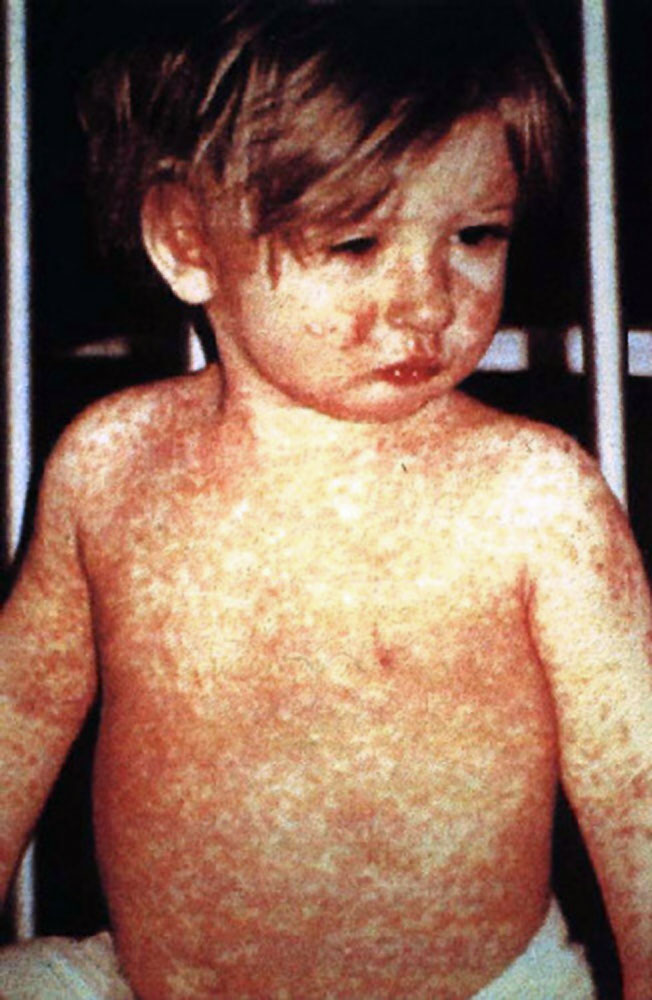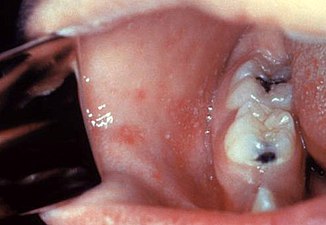
Measles
Measles is a highly contagious, vaccine-preventable infectious disease caused by measles virus.[3][5][11][12][13] Symptoms usually develop 10–12 days after exposure to an infected person and last 7–10 days.[7][8] Initial symptoms typically include fever, often greater than 40 °C (104 °F), cough, runny nose, and inflamed eyes.[3][4] Small white spots known as Koplik's spots may form inside the mouth two or three days after the start of symptoms.[4] A red, flat rash which usually starts on the face and then spreads to the rest of the body typically begins three to five days after the start of symptoms.[4] Common complications include diarrhea (in 8% of cases), middle ear infection (7%), and pneumonia (6%).[5] These occur in part due to measles-induced immunosuppression.[6] Less commonly seizures, blindness, or inflammation of the brain may occur.[5][7] Other names include morbilli, rubeola, red measles, and English measles.[1][2] Both rubella, also known as German measles, and roseola are different diseases caused by unrelated viruses.[14]
This article is about the disease. For other uses, see Measles (disambiguation).Measles
Pneumonia, seizures, encephalitis, subacute sclerosing panencephalitis, immunosuppression, hearing loss, blindness[5][6]
20 million per year[3]
Measles is an airborne disease which spreads easily from one person to the next through the coughs and sneezes of infected people.[7] It may also be spread through direct contact with mouth or nasal secretions.[15] It is extremely contagious: nine out of ten people who are not immune and share living space with an infected person will be infected.[5] Furthermore, measles's reproductive number estimates vary beyond the frequently cited range of 12 to 18.[16] The NIH quote this 2017 paper saying: "[a] review in 2017 identified feasible measles R0 values of 3.7–203.3".[17] People are infectious to others from four days before to four days after the start of the rash.[5] While often regarded as a childhood illness, it can affect people of any age.[18] Most people do not get the disease more than once.[7] Testing for the measles virus in suspected cases is important for public health efforts.[5] Measles is not known to occur in other animals.[15]
Once a person has become infected, no specific treatment is available,[15] although supportive care may improve outcomes.[7] Such care may include oral rehydration solution (slightly sweet and salty fluids), healthy food, and medications to control the fever.[7][8] Antibiotics should be prescribed if secondary bacterial infections such as ear infections or pneumonia occur.[7][15] Vitamin A supplementation is also recommended for children.[15] Among cases reported in the U.S. between 1985 and 1992, death occurred in only 0.2% of cases,[5] but may be up to 10% in people with malnutrition.[7] Most of those who die from the infection are less than five years old.[15]
The measles vaccine is effective at preventing the disease, is exceptionally safe, and is often delivered in combination with other vaccines.[7][19] Vaccination resulted in an 80% decrease in deaths from measles between 2000 and 2017, with about 85% of children worldwide having received their first dose as of 2017.[15]
Measles affects about 20 million people a year,[3] primarily in the developing areas of Africa and Asia.[7] It is one of the leading vaccine-preventable disease causes of death.[20][21] In 1980, 2.6 million people died from measles,[7] and in 1990, 545,000 died due to the disease; by 2014, global vaccination programs had reduced the number of deaths from measles to 73,000.[22][23] Despite these trends, rates of disease and deaths increased from 2017 to 2019 due to a decrease in immunization.[24][25][26]
Prognosis
Most people survive measles, though in some cases, complications may occur. About 1 in 4 individuals will be hospitalized and 1–2 in 1,000 will die. Complications are more likely in children under age 5 and adults over age 20.[87] Pneumonia is the most common fatal complication of measles infection and accounts for 56–86% of measles-related deaths.[88]
Possible consequences of measles virus infection include laryngotracheobronchitis, sensorineural hearing loss,[50] and—in about 1 in 10,000 to 1 in 300,000 cases[89]—panencephalitis, which is usually fatal.[90] Acute measles encephalitis is another serious risk of measles virus infection. It typically occurs two days to one week after the measles rash breaks out and begins with very high fever, severe headache, convulsions and altered mentation. A person with measles encephalitis may become comatose, and death or brain injury may occur.[91]
For people having had measles, it is rare to ever have a symptomatic reinfection.[92]
The measles virus can deplete previously acquired immune memory by killing cells that make antibodies, and thus weakens the immune system, which can cause deaths from other diseases.[41][42][43] Suppression of the immune system by measles lasts about two years and has been epidemiologically implicated in up to 90% of childhood deaths in third world countries, and historically may have caused rather more deaths in the United States, the UK and Denmark than were directly caused by measles.[93] Although the measles vaccine contains an attenuated strain, it does not deplete immune memory.[42]
Research
In May 2015, the journal Science published a report in which researchers found that the measles infection can leave a population at increased risk for mortality from other diseases for two to three years.[93] Results from additional studies that show the measles virus can kill cells that make antibodies were published in November 2019.[42]
A specific drug treatment for measles, ERDRP-0519, has shown promising results in animal studies, but has not yet been tested in humans.[189][190]


